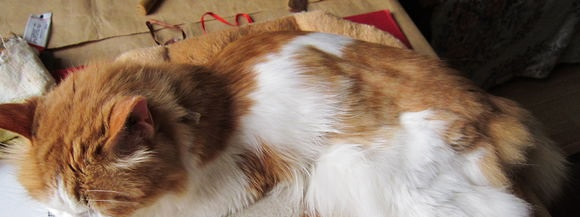Feline diabetes is a nutritional metabolic syndrome caused by defective insulin secretion or impaired biological action, or both.
Figure 1 Sick cat with apathy and mild dehydration
I. Incidence
Brown pear flower (details) cat, ten years old, female cat, weighing nine kilograms, the pet owner found that the cat has lost appetite and lack of energy in recent days, the cat has increased appetite, increased urine output, and has rotten apples

Figure 2 Palpation of the abdomen with a sense of fluctuation
Second, laboratory examination
1. Routine blood test
The results of routine blood test analysis are as follows:
Table 1 Blood routine examination
project | Numerical value | unit |
leukocyte | 37.5 | 109/L |
red blood cells | 16.5 | 1012/L |
neutrophils | 18.5 | 109/L |
monocytes | 5.5 | 109/L |
It can be seen from the table that all the values are higher than normal values.
2. Serum biochemical examination
The results of blood biochemical analysis are as follows:
Table 2 Blood biochemical tests
project | Numerical value | unit |
glucose | 25 | mmol/L |
triglycerides | 5.5 | mmol/L |
total cholesterol | 11 | mmol/L |
globulin | 46 | g/L |
albumin | 29 | g/L |
white ball ratio | 0.58 |
The results in the table are as follows: Glucose, triglyceride, total cholesterol, and globulin were all increased compared with the normal reference value; albumin was lower than the normal value, and A/G was decreased.
3. Urine test
Urinalysis was performed with a Mindray urine analyzer.
4. Imaging examination
Abdominal lateral examination with X-ray machine, the examination results are: abdominal uterine horn enlargement, gray shadow filled with fluid.
5. B ultrasound image examination
Abdominal examination was carried out with B-ultrasound machine, and the examination results were: abdominal uterine horn swelling, uterine wall thickening, and liquid black shadow.
III. Clinical diagnosis
The inquiries revealed that the cat had been obese before the onset of the disease, and often ate meat and fish with high fat content. According to the general clinical symptoms and general clinical physical examination, the disease could be initially diagnosed as diabetes complicated with pyometra.
Figure 3 Sick cat lethargy
4. Treatment
According to the cat's examination, the treatment plan was to use insulin to lower blood sugar, use lipid-lowering drugs to lower blood lipids, infusion to correct water-electrolyte and acid-base balance disorders, combined with symptomatic therapy and diet therapy.
1. Insulin combined with hypoglycemic drug therapy
Synthetic long-acting insulin was used to subcutaneously inject 8 U half an hour before feeding in the morning and evening, and 1.6 mg of Youjiangsu was orally administered after meals, once a day; Lipingzhi was orally administered twice a day.
Figure 4 Insulin can lower blood sugar
2. Daily feeding and management
Daily regular and quantitative feeding of Royal Diabetes Prescription cat food, control the total water intake, and take a small amount of drinking water several times.
3. Symptomatic therapy and control of secondary infections
Intravenous infusion of lactated Ringer's solution and normal saline.
Figure 5 Insulin special syringe
4. Hysterectomy and oophorectomy
After a period of treatment, the cat's physical condition gradually recovered, and hysterectomy and oophorectomy were basically performed under surgical conditions.
V. Discussion and Summary
1. Obesity is the cause of diabetes. The increase in blood glucose concentration caused by diabetes stimulates the hypothalamic feeding center to increase appetite, which also increases plasma osmotic pressure and vascular permeability, resulting in a positive clinical urine glucose test; at the same time, due to the decomposition of glucose
2. When treating diabetes in cats, we must pay attention to the dosage of insulin. If the dosage is too much, it will cause iatrogenic hypoglycemia.
3. The treatment of diabetes should attach great importance to the treatment of complications, and once the symptoms similar to diabetes are found, they should be treated as soon as possible to avoid delaying the best time for treatment.
